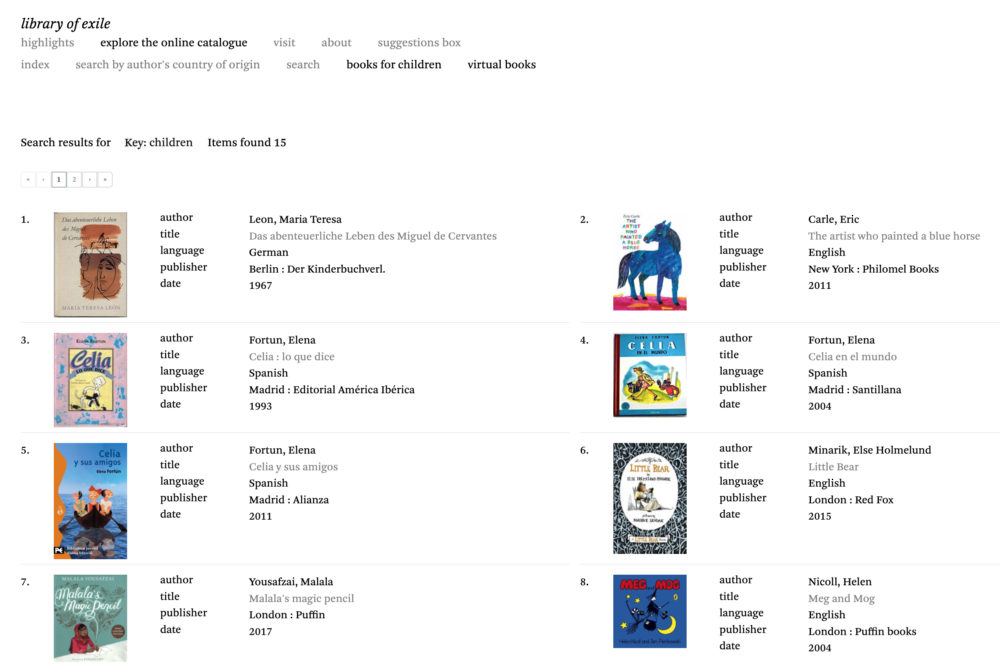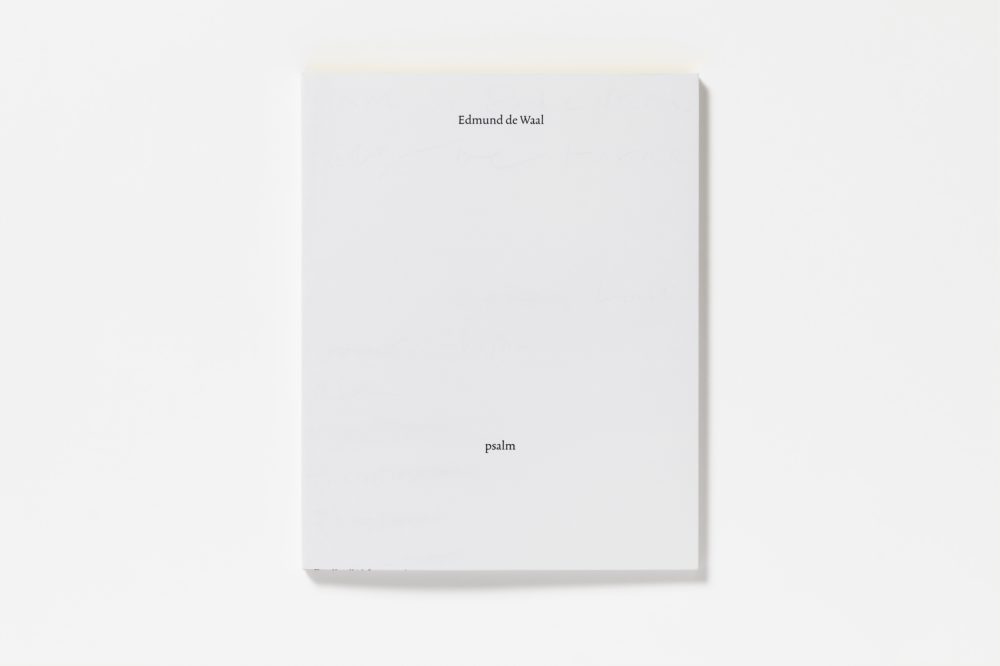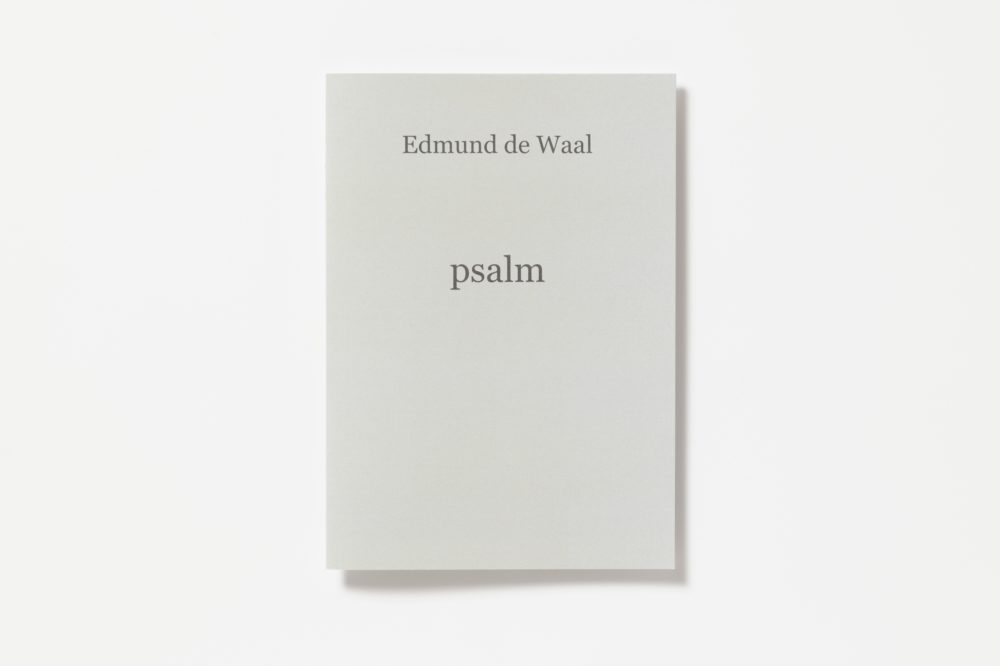
library of exile (installation view)2019
psalm
Ateneo Veneto and Jewish Museum, Venice
8 May – 29 September 2019
psalm, an exhibition in two parts, is a major new project for Venice, unveiled during the Biennale's preview week in May.
The first part of psalm is located in the historic Jewish Ghetto. Here, ten recent works have been installed in the spaces surrounding the Canto Scuola, a beautiful 16th-century synagogue housed by the Jewish Museum: for de Waal, 'one of the great unknown places in the city'.
The second part is the library of exile; a temporary pavilion built within the Ateneo Veneto, holding almost 2,000 books by exiled writers, from Ovid to the present day. Visitors are encouraged to sit and read the books, almost all of which are in translation, reflecting the idea of language as migration. Embedded in the shelves are four of de Waal's large-scale vitrines; their arrangements echoing the first ever printing of the Talmud, printed in Venice.
Throughout the summer there will be a rich programme of events listed on the project's dedicated website.
Photography: Hélène Binet & Fulvio Orsenigo

library of exile (installation view)2019
psalm
Ateneo Veneto and Jewish Museum, Venice
8 May – 29 September 2019
psalm, an exhibition in two parts, is a major new project for Venice, unveiled during the Biennale's preview week in May.
The first part of psalm is located in the historic Jewish Ghetto. Here, ten recent works have been installed in the spaces surrounding the Canto Scuola, a beautiful 16th-century synagogue housed by the Jewish Museum: for de Waal, 'one of the great unknown places in the city'.
The second part is the library of exile; a temporary pavilion built within the Ateneo Veneto, holding almost 2,000 books by exiled writers, from Ovid to the present day. Visitors are encouraged to sit and read the books, almost all of which are in translation, reflecting the idea of language as migration. Embedded in the shelves are four of de Waal's large-scale vitrines; their arrangements echoing the first ever printing of the Talmud, printed in Venice.
Throughout the summer there will be a rich programme of events listed on the project's dedicated website.
Photography: Hélène Binet & Fulvio Orsenigo

library of exile (installation view)2019
psalm
Ateneo Veneto and Jewish Museum, Venice
8 May – 29 September 2019
psalm, an exhibition in two parts, is a major new project for Venice, unveiled during the Biennale's preview week in May.
The first part of psalm is located in the historic Jewish Ghetto. Here, ten recent works have been installed in the spaces surrounding the Canto Scuola, a beautiful 16th-century synagogue housed by the Jewish Museum: for de Waal, 'one of the great unknown places in the city'.
The second part is the library of exile; a temporary pavilion built within the Ateneo Veneto, holding almost 2,000 books by exiled writers, from Ovid to the present day. Visitors are encouraged to sit and read the books, almost all of which are in translation, reflecting the idea of language as migration. Embedded in the shelves are four of de Waal's large-scale vitrines; their arrangements echoing the first ever printing of the Talmud, printed in Venice.
Throughout the summer there will be a rich programme of events listed on the project's dedicated website.
Photography: Hélène Binet & Fulvio Orsenigo

library of exile (installation view)2019
psalm
Ateneo Veneto and Jewish Museum, Venice
8 May – 29 September 2019
psalm, an exhibition in two parts, is a major new project for Venice, unveiled during the Biennale's preview week in May.
The first part of psalm is located in the historic Jewish Ghetto. Here, ten recent works have been installed in the spaces surrounding the Canto Scuola, a beautiful 16th-century synagogue housed by the Jewish Museum: for de Waal, 'one of the great unknown places in the city'.
The second part is the library of exile; a temporary pavilion built within the Ateneo Veneto, holding almost 2,000 books by exiled writers, from Ovid to the present day. Visitors are encouraged to sit and read the books, almost all of which are in translation, reflecting the idea of language as migration. Embedded in the shelves are four of de Waal's large-scale vitrines; their arrangements echoing the first ever printing of the Talmud, printed in Venice.
Throughout the summer there will be a rich programme of events listed on the project's dedicated website.
Photography: Hélène Binet & Fulvio Orsenigo

library of exile (installation view)2019
psalm
Ateneo Veneto and Jewish Museum, Venice
8 May – 29 September 2019
psalm, an exhibition in two parts, is a major new project for Venice, unveiled during the Biennale's preview week in May.
The first part of psalm is located in the historic Jewish Ghetto. Here, ten recent works have been installed in the spaces surrounding the Canto Scuola, a beautiful 16th-century synagogue housed by the Jewish Museum: for de Waal, 'one of the great unknown places in the city'.
The second part is the library of exile; a temporary pavilion built within the Ateneo Veneto, holding almost 2,000 books by exiled writers, from Ovid to the present day. Visitors are encouraged to sit and read the books, almost all of which are in translation, reflecting the idea of language as migration. Embedded in the shelves are four of de Waal's large-scale vitrines; their arrangements echoing the first ever printing of the Talmud, printed in Venice.
Throughout the summer there will be a rich programme of events listed on the project's dedicated website.
Photography: Hélène Binet & Fulvio Orsenigo
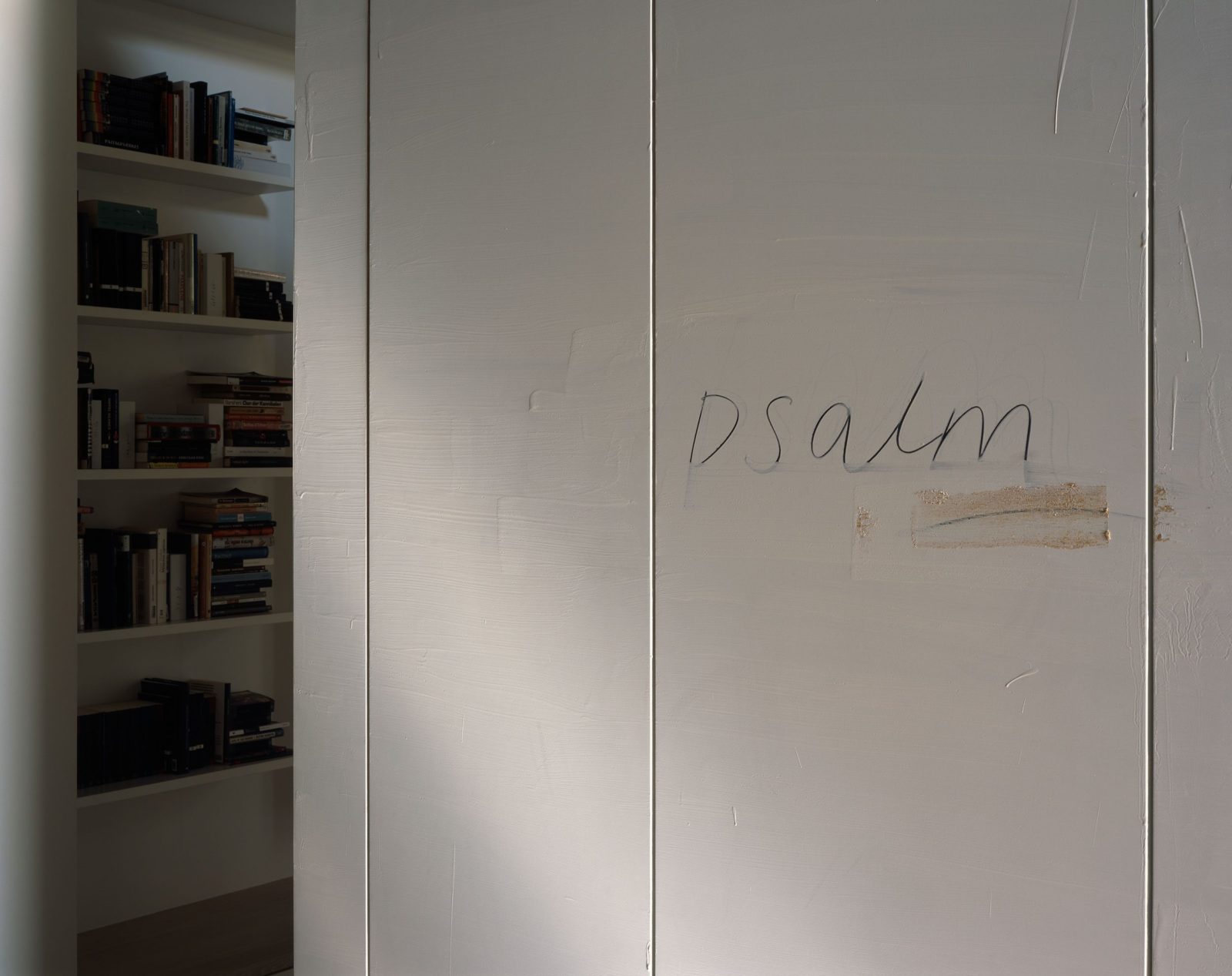
library of exile (installation view)2019
psalm
Ateneo Veneto and Jewish Museum, Venice
8 May – 29 September 2019
psalm, an exhibition in two parts, is a major new project for Venice, unveiled during the Biennale's preview week in May.
The first part of psalm is located in the historic Jewish Ghetto. Here, ten recent works have been installed in the spaces surrounding the Canto Scuola, a beautiful 16th-century synagogue housed by the Jewish Museum: for de Waal, 'one of the great unknown places in the city'.
The second part is the library of exile; a temporary pavilion built within the Ateneo Veneto, holding almost 2,000 books by exiled writers, from Ovid to the present day. Visitors are encouraged to sit and read the books, almost all of which are in translation, reflecting the idea of language as migration. Embedded in the shelves are four of de Waal's large-scale vitrines; their arrangements echoing the first ever printing of the Talmud, printed in Venice.
Throughout the summer there will be a rich programme of events listed on the project's dedicated website.
Photography: Hélène Binet & Fulvio Orsenigo

library of exile (installation view)2019
psalm
Ateneo Veneto and Jewish Museum, Venice
8 May – 29 September 2019
psalm, an exhibition in two parts, is a major new project for Venice, unveiled during the Biennale's preview week in May.
The first part of psalm is located in the historic Jewish Ghetto. Here, ten recent works have been installed in the spaces surrounding the Canto Scuola, a beautiful 16th-century synagogue housed by the Jewish Museum: for de Waal, 'one of the great unknown places in the city'.
The second part is the library of exile; a temporary pavilion built within the Ateneo Veneto, holding almost 2,000 books by exiled writers, from Ovid to the present day. Visitors are encouraged to sit and read the books, almost all of which are in translation, reflecting the idea of language as migration. Embedded in the shelves are four of de Waal's large-scale vitrines; their arrangements echoing the first ever printing of the Talmud, printed in Venice.
Throughout the summer there will be a rich programme of events listed on the project's dedicated website.
Photography: Hélène Binet & Fulvio Orsenigo

library of exile (installation view)2019
psalm
Ateneo Veneto and Jewish Museum, Venice
8 May – 29 September 2019
psalm, an exhibition in two parts, is a major new project for Venice, unveiled during the Biennale's preview week in May.
The first part of psalm is located in the historic Jewish Ghetto. Here, ten recent works have been installed in the spaces surrounding the Canto Scuola, a beautiful 16th-century synagogue housed by the Jewish Museum: for de Waal, 'one of the great unknown places in the city'.
The second part is the library of exile; a temporary pavilion built within the Ateneo Veneto, holding almost 2,000 books by exiled writers, from Ovid to the present day. Visitors are encouraged to sit and read the books, almost all of which are in translation, reflecting the idea of language as migration. Embedded in the shelves are four of de Waal's large-scale vitrines; their arrangements echoing the first ever printing of the Talmud, printed in Venice.
Throughout the summer there will be a rich programme of events listed on the project's dedicated website.
Photography: Hélène Binet & Fulvio Orsenigo
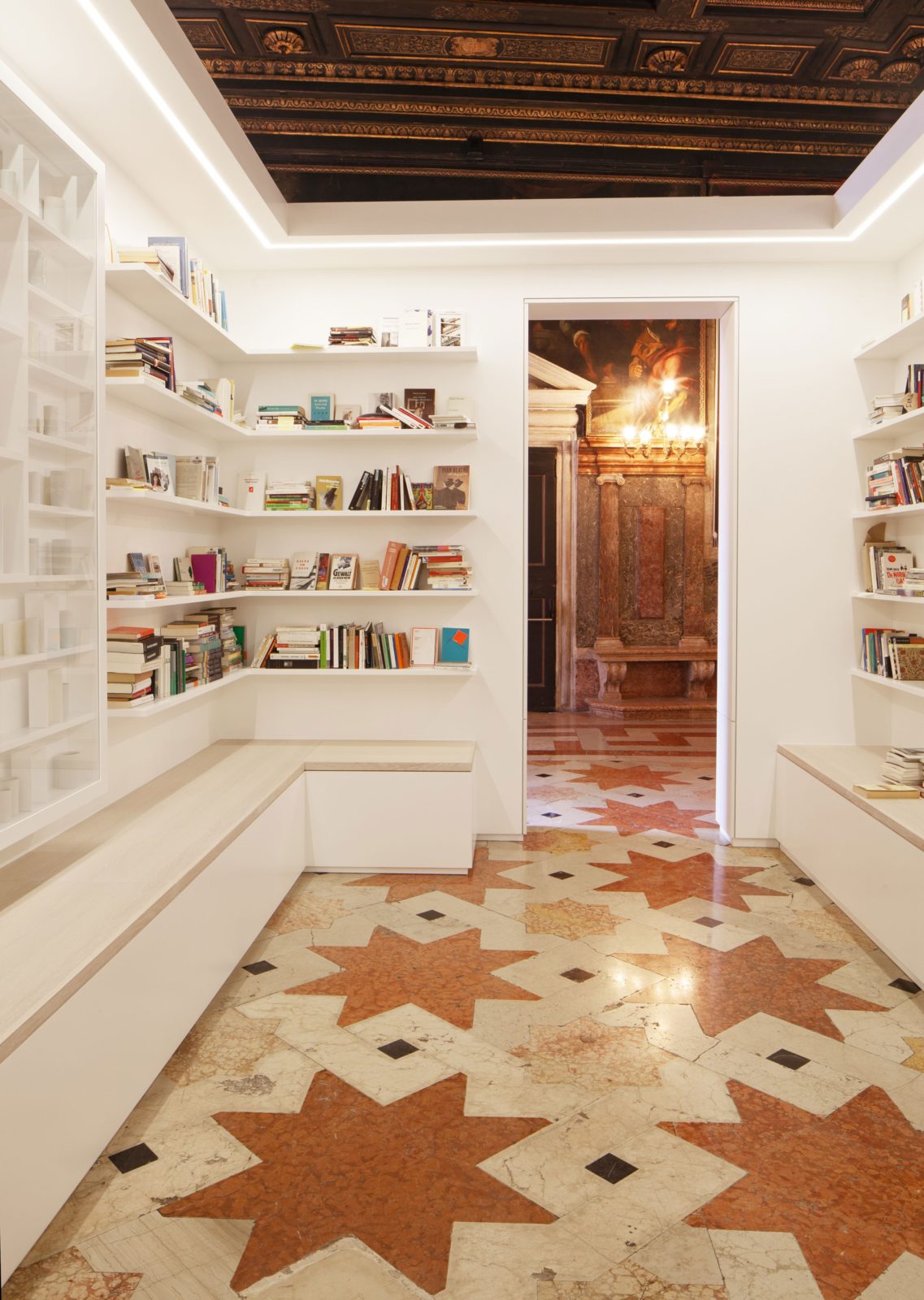
library of exile (installation view)2019
psalm
Ateneo Veneto and Jewish Museum, Venice
8 May – 29 September 2019
psalm, an exhibition in two parts, is a major new project for Venice, unveiled during the Biennale's preview week in May.
The first part of psalm is located in the historic Jewish Ghetto. Here, ten recent works have been installed in the spaces surrounding the Canto Scuola, a beautiful 16th-century synagogue housed by the Jewish Museum: for de Waal, 'one of the great unknown places in the city'.
The second part is the library of exile; a temporary pavilion built within the Ateneo Veneto, holding almost 2,000 books by exiled writers, from Ovid to the present day. Visitors are encouraged to sit and read the books, almost all of which are in translation, reflecting the idea of language as migration. Embedded in the shelves are four of de Waal's large-scale vitrines; their arrangements echoing the first ever printing of the Talmud, printed in Venice.
Throughout the summer there will be a rich programme of events listed on the project's dedicated website.
Photography: Hélène Binet & Fulvio Orsenigo

library of exile (installation view)2019
psalm
Ateneo Veneto and Jewish Museum, Venice
8 May – 29 September 2019
psalm, an exhibition in two parts, is a major new project for Venice, unveiled during the Biennale's preview week in May.
The first part of psalm is located in the historic Jewish Ghetto. Here, ten recent works have been installed in the spaces surrounding the Canto Scuola, a beautiful 16th-century synagogue housed by the Jewish Museum: for de Waal, 'one of the great unknown places in the city'.
The second part is the library of exile; a temporary pavilion built within the Ateneo Veneto, holding almost 2,000 books by exiled writers, from Ovid to the present day. Visitors are encouraged to sit and read the books, almost all of which are in translation, reflecting the idea of language as migration. Embedded in the shelves are four of de Waal's large-scale vitrines; their arrangements echoing the first ever printing of the Talmud, printed in Venice.
Throughout the summer there will be a rich programme of events listed on the project's dedicated website.
Photography: Hélène Binet & Fulvio Orsenigo

library of exile (installation view)2019
psalm
Ateneo Veneto and Jewish Museum, Venice
8 May – 29 September 2019
psalm, an exhibition in two parts, is a major new project for Venice, unveiled during the Biennale's preview week in May.
The first part of psalm is located in the historic Jewish Ghetto. Here, ten recent works have been installed in the spaces surrounding the Canto Scuola, a beautiful 16th-century synagogue housed by the Jewish Museum: for de Waal, 'one of the great unknown places in the city'.
The second part is the library of exile; a temporary pavilion built within the Ateneo Veneto, holding almost 2,000 books by exiled writers, from Ovid to the present day. Visitors are encouraged to sit and read the books, almost all of which are in translation, reflecting the idea of language as migration. Embedded in the shelves are four of de Waal's large-scale vitrines; their arrangements echoing the first ever printing of the Talmud, printed in Venice.
Throughout the summer there will be a rich programme of events listed on the project's dedicated website.
Photography: Hélène Binet & Fulvio Orsenigo

library of exile (installation view)2019
psalm
Ateneo Veneto and Jewish Museum, Venice
8 May – 29 September 2019
psalm, an exhibition in two parts, is a major new project for Venice, unveiled during the Biennale's preview week in May.
The first part of psalm is located in the historic Jewish Ghetto. Here, ten recent works have been installed in the spaces surrounding the Canto Scuola, a beautiful 16th-century synagogue housed by the Jewish Museum: for de Waal, 'one of the great unknown places in the city'.
The second part is the library of exile; a temporary pavilion built within the Ateneo Veneto, holding almost 2,000 books by exiled writers, from Ovid to the present day. Visitors are encouraged to sit and read the books, almost all of which are in translation, reflecting the idea of language as migration. Embedded in the shelves are four of de Waal's large-scale vitrines; their arrangements echoing the first ever printing of the Talmud, printed in Venice.
Throughout the summer there will be a rich programme of events listed on the project's dedicated website.
Photography: Hélène Binet & Fulvio Orsenigo

library of exile (installation view)2019
psalm
Ateneo Veneto and Jewish Museum, Venice
8 May – 29 September 2019
psalm, an exhibition in two parts, is a major new project for Venice, unveiled during the Biennale's preview week in May.
The first part of psalm is located in the historic Jewish Ghetto. Here, ten recent works have been installed in the spaces surrounding the Canto Scuola, a beautiful 16th-century synagogue housed by the Jewish Museum: for de Waal, 'one of the great unknown places in the city'.
The second part is the library of exile; a temporary pavilion built within the Ateneo Veneto, holding almost 2,000 books by exiled writers, from Ovid to the present day. Visitors are encouraged to sit and read the books, almost all of which are in translation, reflecting the idea of language as migration. Embedded in the shelves are four of de Waal's large-scale vitrines; their arrangements echoing the first ever printing of the Talmud, printed in Venice.
Throughout the summer there will be a rich programme of events listed on the project's dedicated website.
Photography: Hélène Binet & Fulvio Orsenigo

library of exile (installation view)2019
psalm
Ateneo Veneto and Jewish Museum, Venice
8 May – 29 September 2019
psalm, an exhibition in two parts, is a major new project for Venice, unveiled during the Biennale's preview week in May.
The first part of psalm is located in the historic Jewish Ghetto. Here, ten recent works have been installed in the spaces surrounding the Canto Scuola, a beautiful 16th-century synagogue housed by the Jewish Museum: for de Waal, 'one of the great unknown places in the city'.
The second part is the library of exile; a temporary pavilion built within the Ateneo Veneto, holding almost 2,000 books by exiled writers, from Ovid to the present day. Visitors are encouraged to sit and read the books, almost all of which are in translation, reflecting the idea of language as migration. Embedded in the shelves are four of de Waal's large-scale vitrines; their arrangements echoing the first ever printing of the Talmud, printed in Venice.
Throughout the summer there will be a rich programme of events listed on the project's dedicated website.
Photography: Hélène Binet & Fulvio Orsenigo
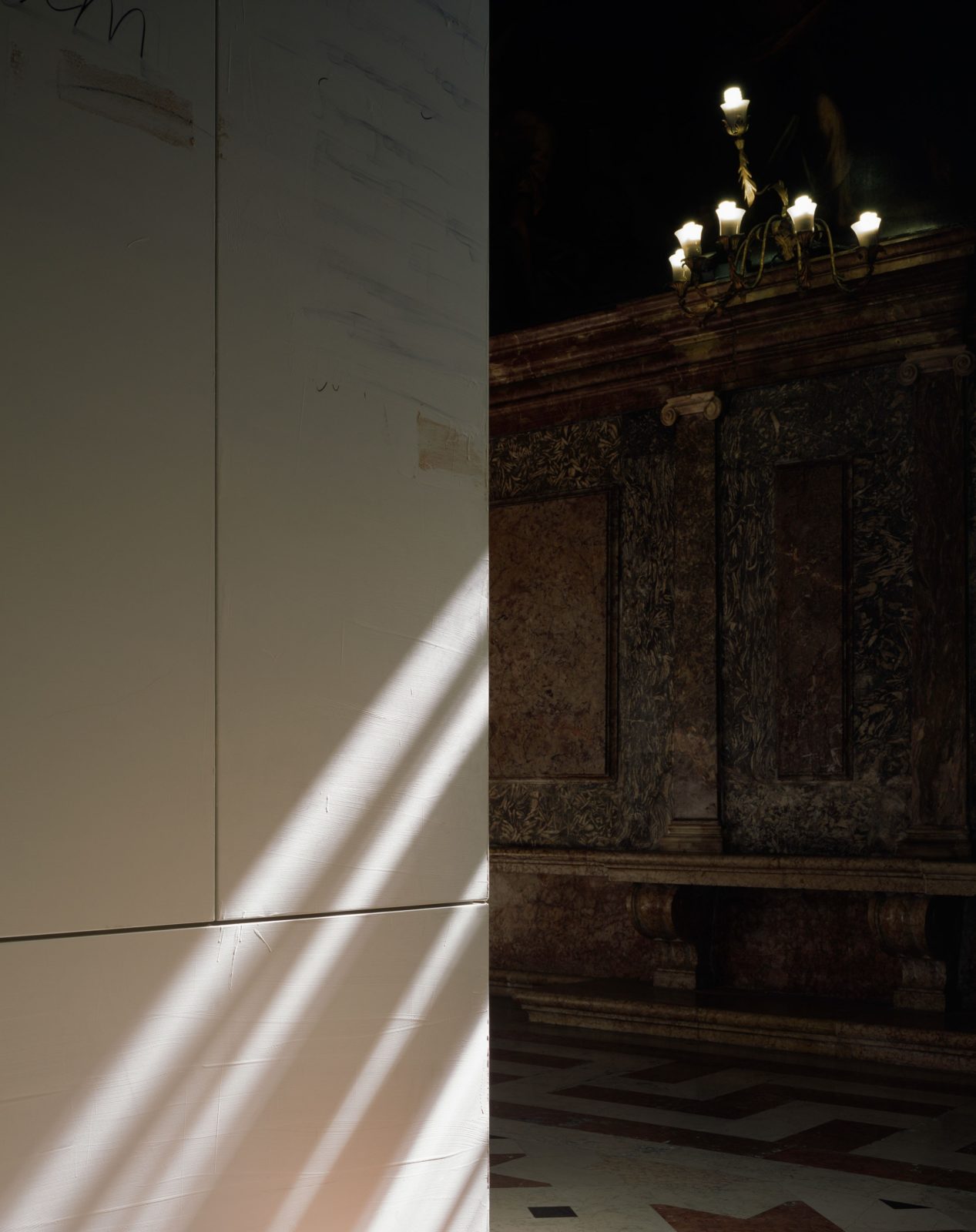
library of exile (installation view)2019
psalm
Ateneo Veneto and Jewish Museum, Venice
8 May – 29 September 2019
psalm, an exhibition in two parts, is a major new project for Venice, unveiled during the Biennale's preview week in May.
The first part of psalm is located in the historic Jewish Ghetto. Here, ten recent works have been installed in the spaces surrounding the Canto Scuola, a beautiful 16th-century synagogue housed by the Jewish Museum: for de Waal, 'one of the great unknown places in the city'.
The second part is the library of exile; a temporary pavilion built within the Ateneo Veneto, holding almost 2,000 books by exiled writers, from Ovid to the present day. Visitors are encouraged to sit and read the books, almost all of which are in translation, reflecting the idea of language as migration. Embedded in the shelves are four of de Waal's large-scale vitrines; their arrangements echoing the first ever printing of the Talmud, printed in Venice.
Throughout the summer there will be a rich programme of events listed on the project's dedicated website.
Photography: Hélène Binet & Fulvio Orsenigo

Adonai2019
psalm
Ateneo Veneto and Jewish Museum, Venice
8 May – 29 September 2019
psalm, an exhibition in two parts, is a major new project for Venice, unveiled during the Biennale's preview week in May.
The first part of psalm is located in the historic Jewish Ghetto. Here, ten recent works have been installed in the spaces surrounding the Canto Scuola, a beautiful 16th-century synagogue housed by the Jewish Museum: for de Waal, 'one of the great unknown places in the city'.
The second part is the library of exile; a temporary pavilion built within the Ateneo Veneto, holding almost 2,000 books by exiled writers, from Ovid to the present day. Visitors are encouraged to sit and read the books, almost all of which are in translation, reflecting the idea of language as migration. Embedded in the shelves are four of de Waal's large-scale vitrines; their arrangements echoing the first ever printing of the Talmud, printed in Venice.
Throughout the summer there will be a rich programme of events listed on the project's dedicated website.
Photography: Hélène Binet & Fulvio Orsenigo
a different breath, 2018

a different breath, 2018
psalm
Ateneo Veneto and Jewish Museum, Venice
8 May – 29 September 2019
psalm, an exhibition in two parts, is a major new project for Venice, unveiled during the Biennale's preview week in May.
The first part of psalm is located in the historic Jewish Ghetto. Here, ten recent works have been installed in the spaces surrounding the Canto Scuola, a beautiful 16th-century synagogue housed by the Jewish Museum: for de Waal, 'one of the great unknown places in the city'.
The second part is the library of exile; a temporary pavilion built within the Ateneo Veneto, holding almost 2,000 books by exiled writers, from Ovid to the present day. Visitors are encouraged to sit and read the books, almost all of which are in translation, reflecting the idea of language as migration. Embedded in the shelves are four of de Waal's large-scale vitrines; their arrangements echoing the first ever printing of the Talmud, printed in Venice.
Throughout the summer there will be a rich programme of events listed on the project's dedicated website.
Photography: Hélène Binet & Fulvio Orsenigo
tehillim, 2018

tehillim, 2018
psalm
Ateneo Veneto and Jewish Museum, Venice
8 May – 29 September 2019
psalm, an exhibition in two parts, is a major new project for Venice, unveiled during the Biennale's preview week in May.
The first part of psalm is located in the historic Jewish Ghetto. Here, ten recent works have been installed in the spaces surrounding the Canto Scuola, a beautiful 16th-century synagogue housed by the Jewish Museum: for de Waal, 'one of the great unknown places in the city'.
The second part is the library of exile; a temporary pavilion built within the Ateneo Veneto, holding almost 2,000 books by exiled writers, from Ovid to the present day. Visitors are encouraged to sit and read the books, almost all of which are in translation, reflecting the idea of language as migration. Embedded in the shelves are four of de Waal's large-scale vitrines; their arrangements echoing the first ever printing of the Talmud, printed in Venice.
Throughout the summer there will be a rich programme of events listed on the project's dedicated website.
Photography: Hélène Binet & Fulvio Orsenigo
tehillim, 2018

tehillim, 2018
psalm
Ateneo Veneto and Jewish Museum, Venice
8 May – 29 September 2019
psalm, an exhibition in two parts, is a major new project for Venice, unveiled during the Biennale's preview week in May.
The first part of psalm is located in the historic Jewish Ghetto. Here, ten recent works have been installed in the spaces surrounding the Canto Scuola, a beautiful 16th-century synagogue housed by the Jewish Museum: for de Waal, 'one of the great unknown places in the city'.
The second part is the library of exile; a temporary pavilion built within the Ateneo Veneto, holding almost 2,000 books by exiled writers, from Ovid to the present day. Visitors are encouraged to sit and read the books, almost all of which are in translation, reflecting the idea of language as migration. Embedded in the shelves are four of de Waal's large-scale vitrines; their arrangements echoing the first ever printing of the Talmud, printed in Venice.
Throughout the summer there will be a rich programme of events listed on the project's dedicated website.
Photography: Hélène Binet & Fulvio Orsenigo

Sukkah2019
psalm
Ateneo Veneto and Jewish Museum, Venice
8 May – 29 September 2019
psalm, an exhibition in two parts, is a major new project for Venice, unveiled during the Biennale's preview week in May.
The first part of psalm is located in the historic Jewish Ghetto. Here, ten recent works have been installed in the spaces surrounding the Canto Scuola, a beautiful 16th-century synagogue housed by the Jewish Museum: for de Waal, 'one of the great unknown places in the city'.
The second part is the library of exile; a temporary pavilion built within the Ateneo Veneto, holding almost 2,000 books by exiled writers, from Ovid to the present day. Visitors are encouraged to sit and read the books, almost all of which are in translation, reflecting the idea of language as migration. Embedded in the shelves are four of de Waal's large-scale vitrines; their arrangements echoing the first ever printing of the Talmud, printed in Venice.
Throughout the summer there will be a rich programme of events listed on the project's dedicated website.
Photography: Hélène Binet & Fulvio Orsenigo

Sukkah2019
psalm
Ateneo Veneto and Jewish Museum, Venice
8 May – 29 September 2019
psalm, an exhibition in two parts, is a major new project for Venice, unveiled during the Biennale's preview week in May.
The first part of psalm is located in the historic Jewish Ghetto. Here, ten recent works have been installed in the spaces surrounding the Canto Scuola, a beautiful 16th-century synagogue housed by the Jewish Museum: for de Waal, 'one of the great unknown places in the city'.
The second part is the library of exile; a temporary pavilion built within the Ateneo Veneto, holding almost 2,000 books by exiled writers, from Ovid to the present day. Visitors are encouraged to sit and read the books, almost all of which are in translation, reflecting the idea of language as migration. Embedded in the shelves are four of de Waal's large-scale vitrines; their arrangements echoing the first ever printing of the Talmud, printed in Venice.
Throughout the summer there will be a rich programme of events listed on the project's dedicated website.
Photography: Hélène Binet & Fulvio Orsenigo

Sukkah2019
psalm
Ateneo Veneto and Jewish Museum, Venice
8 May – 29 September 2019
psalm, an exhibition in two parts, is a major new project for Venice, unveiled during the Biennale's preview week in May.
The first part of psalm is located in the historic Jewish Ghetto. Here, ten recent works have been installed in the spaces surrounding the Canto Scuola, a beautiful 16th-century synagogue housed by the Jewish Museum: for de Waal, 'one of the great unknown places in the city'.
The second part is the library of exile; a temporary pavilion built within the Ateneo Veneto, holding almost 2,000 books by exiled writers, from Ovid to the present day. Visitors are encouraged to sit and read the books, almost all of which are in translation, reflecting the idea of language as migration. Embedded in the shelves are four of de Waal's large-scale vitrines; their arrangements echoing the first ever printing of the Talmud, printed in Venice.
Throughout the summer there will be a rich programme of events listed on the project's dedicated website.
Photography: Hélène Binet & Fulvio Orsenigo
